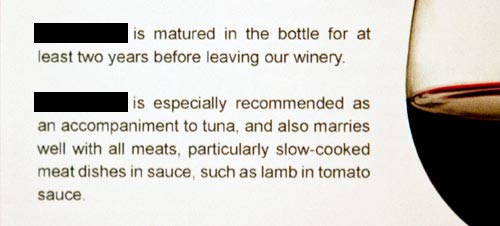
[wine] is matured in the bottle for at least two years before leaving our winery.
[wine] is especially recommended as accompaniment to tuna, and marries well with all meats, particularly slow-cooked meat dishes in sauce, such as lamb in tomato sauce.
This is the description for an excellent wine, from a winery in Priorat that we quite liked and that has wonderful, friendly owners. Despite all this and the fact that we actually have bought this wine several times since visiting the winery, this description commits the two most common sins for Spanish/Catalan speakers when writing up English descriptions of their wines without consulting native English speakers.
The choice of “matured” while grammatically correct sounds weird, as “aged” is more commonly used in English. This choice of “matured” is due to the use of “maduración” or “maduració” in Spanish and Catalan to express the aging — not that the wine has grown up to be a respectable member of the community. On its own, it’s not that confusing except that by stating “leaving the winery” at the end, it makes it seem like they are growing small children or breeding animals at the winery instead of inanimate bottles of wine.
Moving on is the biggest English language mistranslation in wine descriptions and our personal favorite as it is so prevalent: “marries”. The reason is simple in that they use “maridaje” or “maridatge” in Spanish and Catalan for wine pairing. The wondrous Google Translate takes this literally to mean, “marriage” which it technically does. It just happens to miss the subtle variation of the word to the much more correct, “pairs” in English.
So there you have it, a wine that that marries well once it has matured enough to wear its big boy pants.
I could go on forever with examples from translated menus. The best, however, which had me in stitches was “screwed chicken” instead of “skewered chicken”.